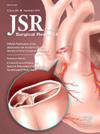Use of Deep Learning to Identify Peripheral Arterial Disease Cases From Narrative Clinical Notes
IF 1.8
3区 医学
Q2 SURGERY
引用次数: 0
Abstract
Introduction
Peripheral arterial disease (PAD) is the leading cause of amputation in the United States. Despite affecting 8.5 million Americans and more than 200 million people globally, there are significant gaps in awareness by both patients and providers. Ongoing efforts to raise PAD awareness among both the public and health-care professionals have not met widespread success. Thus, there is a need for alternative methods for identifying PAD patients. One potentially promising strategy leverages natural language processing (NLP) to digitally screen patients for PAD. Prior approaches have applied keyword search (KWS) to billing codes or unstructured clinical narratives to identify patients with PAD. However, KWS is limited by its lack of flexibility, the need for manual algorithm development, inconsistent validation, and an inherent failure to capture patients with undiagnosed PAD. Recent advances in deep learning (DL) allow modern NLP models to learn a conceptual representation of the verbiage associated with PAD. This capability may overcome the characteristic constraints of applying strict rule-based algorithms (i.e., searching for a disease-defining set of keywords or billing codes) to real-world clinical data. Herein, we investigate the use of DL to identify patients with PAD from unstructured notes in the electronic health record (EHR).
Methods
Using EHR data from a statewide health information exchange, we first created a dataset of all patients with diagnostic or procedural codes (International Classification of Diseases version 9 or 10 or Current Procedural Terminology) for PAD. This study population was then subdivided into training (70%) and testing (30%) cohorts. We based ground truth labels (PAD versus no PAD) on the presence of a primary diagnostic or procedural billing code for PAD at the encounter level. We implemented our KWS-based identification strategy using the currently published state-of-the-art algorithm for identifying PAD cases from unstructured EHR data. We developed a DL model using a BioMed-RoBERTa base that was fine-tuned on the training cohort. We compared the performance of the KWS algorithm to our DL model on a binary classification task (PAD versus no PAD).
Results
Our study included 484,363 encounters across 71,355 patients represented in 2,268,062 notes. For the task of correctly identifying PAD related notes in our testing set, the DL outperformed KWS on all model performance measures (Sens 0.70 versus 0.62; Spec 0.99 versus 0.94; PPV 0.82 versus 0.69; NPV 0.97 versus 0.96; Accuracy 0.96 versus 0.91; P value for all comparisons <0.001).
Conclusions
Our findings suggest that DL outperforms KWS for identifying PAD cases from clinical narratives. Future planned work derived from this project will develop models to stage patients based on clinical scoring systems.
利用深度学习从叙事性临床笔记中识别外周动脉疾病病例。
导言:在美国,外周动脉疾病(PAD)是导致截肢的主要原因。尽管该病影响着 850 万美国人和全球 2 亿多人,但患者和医护人员对该病的认识仍有很大差距。目前,提高公众和医疗保健专业人员对 PAD 认识的努力尚未取得广泛成功。因此,有必要采用其他方法来识别 PAD 患者。利用自然语言处理(NLP)对 PAD 患者进行数字筛查是一种很有前景的策略。之前的方法将关键词搜索(KWS)应用于账单代码或非结构化临床叙述,以识别 PAD 患者。然而,KWS 的局限性在于缺乏灵活性、需要人工开发算法、验证不一致以及无法捕捉未确诊的 PAD 患者。深度学习(DL)的最新进展使现代 NLP 模型能够学习与 PAD 相关的语言的概念表述。这种能力可以克服将严格的基于规则的算法(即搜索一组疾病定义的关键字或账单代码)应用于真实世界临床数据时所受到的限制。在此,我们研究了使用 DL 从电子健康记录(EHR)中的非结构化笔记中识别出 PAD 患者的方法:方法:利用全州范围内健康信息交换中心的电子病历数据,我们首先创建了一个数据集,其中包含所有具有 PAD 诊断或手术代码(国际疾病分类版本 9 或 10 或当前手术术语)的患者。然后将该研究人群细分为训练组群(70%)和测试组群(30%)。我们根据会诊水平上是否存在 PAD 的主要诊断或程序计费代码来确定基本事实标签(PAD 与无 PAD)。我们使用目前已发表的最先进算法实施了基于 KWS 的识别策略,该算法用于从非结构化 EHR 数据中识别 PAD 病例。我们使用 BioMed-RoBERTa 基础开发了一个 DL 模型,该模型在训练队列中进行了微调。我们比较了 KWS 算法和我们的 DL 模型在二元分类任务(PAD 与无 PAD)上的性能:我们的研究包括 2,268,062 张病历中 71,355 名患者的 484,363 次就诊。对于在测试集中正确识别 PAD 相关笔记的任务,DL 在所有模型性能指标上均优于 KWS(Sens 0.70 对 0.62;Spec 0.99 对 0.94;PPV 0.82 对 0.69;NPV 0.97 对 0.96;Accuracy 0.96 对 0.91;所有比较的 P 值 结论:我们的研究结果表明,DL 在所有模型性能指标上均优于 KWS:我们的研究结果表明,在从临床叙述中识别 PAD 病例方面,DL 优于 KWS。本项目的未来计划工作将开发基于临床评分系统的患者分期模型。
本文章由计算机程序翻译,如有差异,请以英文原文为准。
求助全文
约1分钟内获得全文
求助全文
来源期刊
CiteScore
3.90
自引率
4.50%
发文量
627
审稿时长
138 days
期刊介绍:
The Journal of Surgical Research: Clinical and Laboratory Investigation publishes original articles concerned with clinical and laboratory investigations relevant to surgical practice and teaching. The journal emphasizes reports of clinical investigations or fundamental research bearing directly on surgical management that will be of general interest to a broad range of surgeons and surgical researchers. The articles presented need not have been the products of surgeons or of surgical laboratories.
The Journal of Surgical Research also features review articles and special articles relating to educational, research, or social issues of interest to the academic surgical community.

 求助内容:
求助内容: 应助结果提醒方式:
应助结果提醒方式:


